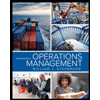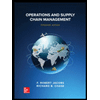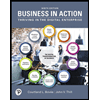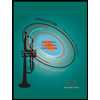Tamara is considering venturing into the public transport system although she is unsure on whether to purchase a 35-seater minibus, a 14-seater matatu or a taxi cab. These respective vehicles have a cost of price of Sh.2.5 million, Sh.2 million and Sh. 1.2 million. The monthly collections from the vehicles would depend on the state of the economy which can be an economic boom, stagnation or recession. The probabilities of these states are 0.25, 0.45 and 0.3 respectively. The estimated monthly collections (in Shillings) are indicated in the table below: Economic Boom Economic Stagnation Economic Recession Required: i. ii. Taxi Cab 60,000 50,000 30,000 Matatu 90,000 75,000 60,000 Mini bus 120,000 90,000 70,000 Tamara would have to borrow 80% of the money required to buy any of the vehicles at an annual interest rate of 12%. In addition, all the vehicles are depreciated at a rate of 20% p.a. on a straight line basis. No other expenses are expected apart from the tax of 30% of the annual profit. The annual profit pay-off matrix in form of a table similar to the one above. 111. The optimal vehicle to be purchased by Tamara using the expected profit criterion The optimal vehicle to be purchased by Tamara given using the Minimax criterion The optimal vehicle to purchase using the Maximin criterion The optimal vehicle to purchase using the Laplace criterion. iv.
Tamara is considering venturing into the public transport system although she is unsure on whether to purchase a 35-seater minibus, a 14-seater matatu or a taxi cab. These respective vehicles have a cost of price of Sh.2.5 million, Sh.2 million and Sh. 1.2 million. The monthly collections from the vehicles would depend on the state of the economy which can be an economic boom, stagnation or recession. The probabilities of these states are 0.25, 0.45 and 0.3 respectively. The estimated monthly collections (in Shillings) are indicated in the table below: Economic Boom Economic Stagnation Economic Recession Required: i. ii. Taxi Cab 60,000 50,000 30,000 Matatu 90,000 75,000 60,000 Mini bus 120,000 90,000 70,000 Tamara would have to borrow 80% of the money required to buy any of the vehicles at an annual interest rate of 12%. In addition, all the vehicles are depreciated at a rate of 20% p.a. on a straight line basis. No other expenses are expected apart from the tax of 30% of the annual profit. The annual profit pay-off matrix in form of a table similar to the one above. 111. The optimal vehicle to be purchased by Tamara using the expected profit criterion The optimal vehicle to be purchased by Tamara given using the Minimax criterion The optimal vehicle to purchase using the Maximin criterion The optimal vehicle to purchase using the Laplace criterion. iv.
Practical Management Science
6th Edition
ISBN:9781337406659
Author:WINSTON, Wayne L.
Publisher:WINSTON, Wayne L.
Chapter2: Introduction To Spreadsheet Modeling
Section: Chapter Questions
Problem 20P: Julie James is opening a lemonade stand. She believes the fixed cost per week of running the stand...
Related questions
Question

Transcribed Image Text:Tamara is considering venturing into the public transport system although she is unsure on whether
to purchase a 35-seater minibus, a 14-seater matatu or a taxi cab. These respective vehicles have a
cost of price of Sh.2.5 million, Sh.2 million and Sh. 1.2 million. The monthly collections from the
vehicles would depend on the state of the economy which can be an economic boom, stagnation
or recession. The probabilities of these states are 0.25, 0.45 and 0.3 respectively. The estimated
monthly collections (in Shillings) are indicated in the table below:
Economic Boom
Economic Stagnation
Economic Recession
Taxi Cab
60,000
50,000
30,000
Matatu
www
90,000
75,000
60,000
Mini bus
120,000
90,000
70,000
Tamara would have to borrow 80% of the money required to buy any of the vehicles at an annual
interest rate of 12%. In addition, all the vehicles are depreciated at a rate of 20% p.a. on a straight
line basis. No other expenses are expected apart from the tax of 30% of the annual profit.
Required:
i.
The annual profit pay-off matrix in form of a table similar to the one above.
11.
The optimal vehicle to be purchased by Tamara using the expected profit criterion
The optimal vehicle to be purchased by Tamara given using the Minimax criterion
iv. The optimal vehicle to purchase using the Maximin criterion
iii.
The optimal vehicle to purchase using the Laplace criterion.
Expert Solution
This question has been solved!
Explore an expertly crafted, step-by-step solution for a thorough understanding of key concepts.
Step by step
Solved in 7 steps with 1 images

Recommended textbooks for you

Practical Management Science
Operations Management
ISBN:
9781337406659
Author:
WINSTON, Wayne L.
Publisher:
Cengage,

Operations Management
Operations Management
ISBN:
9781259667473
Author:
William J Stevenson
Publisher:
McGraw-Hill Education

Operations and Supply Chain Management (Mcgraw-hi…
Operations Management
ISBN:
9781259666100
Author:
F. Robert Jacobs, Richard B Chase
Publisher:
McGraw-Hill Education

Practical Management Science
Operations Management
ISBN:
9781337406659
Author:
WINSTON, Wayne L.
Publisher:
Cengage,

Operations Management
Operations Management
ISBN:
9781259667473
Author:
William J Stevenson
Publisher:
McGraw-Hill Education

Operations and Supply Chain Management (Mcgraw-hi…
Operations Management
ISBN:
9781259666100
Author:
F. Robert Jacobs, Richard B Chase
Publisher:
McGraw-Hill Education


Purchasing and Supply Chain Management
Operations Management
ISBN:
9781285869681
Author:
Robert M. Monczka, Robert B. Handfield, Larry C. Giunipero, James L. Patterson
Publisher:
Cengage Learning

Production and Operations Analysis, Seventh Editi…
Operations Management
ISBN:
9781478623069
Author:
Steven Nahmias, Tava Lennon Olsen
Publisher:
Waveland Press, Inc.